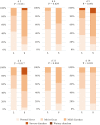Effects of dietary crude protein level and sodium butyrate protected by medium-chain fatty acid salts on performance and gut health in weaned piglets
- PMID: 36967519
- PMCID: PMC10103067
- DOI: 10.1093/jas/skad090
Effects of dietary crude protein level and sodium butyrate protected by medium-chain fatty acid salts on performance and gut health in weaned piglets
Abstract
To reduce the use of antibiotics, research into nutritional strategies designed to improve the gut health of weaned pigs is underway. This study sought to examine the effects of reducing dietary crude protein (CP) and/or supplementing the feed with sodium butyrate protected by the sodium salts of medium-chain fatty acids on the growth performance and gut health of weaned piglets. Ninety-six weaned piglets (Landrace × large white, 21 days of age) were allotted to four experimental treatments for 14 d. The experimental design was factorial with 2 CP levels and 2 feed-additive doses (0 vs. 1 kg/t). Results showed that reducing CP from 22.2% to 18.8% diet had no effect on piglet growth performance parameters during the first post-weaning week (P > 0.05), but did compromise growth in the second week (P = 0.011), impacting overall growth performance results (P = 0.019). Nonetheless, dietary CP level reduction led reducing crypt depth (P = 0.03657). In addition, Lactobacillus counts that were increased in the ileum (P = 0.032) and reduced in the colon (P = 0.032). Furthermore, apparent ileal digestibility of organic matter (P = 0.026) and fecal consistency (P < 0.05) were improved throughout the experiment. Moreover, in piglets fed diets containing 22.2% CP, the use of the feed-additive tended to improve the gain-to-feed ratio (P = 0.091) compared to those fed supplemented diets containing 18.8% CP. In addition, feed supplementation increased ileal numbers of goblet cells (P = 0.036), as well as apparent ileal digestibility of dry matter (P = 0.057) and organic matter (P = 0.003). Supplementation also had beneficial effects on the microbiota of the colon, increasing Lactobacillus counts (P = 0.006) and diminishing Enterobacteriaceae counts (P = 0.003), as well as affecting microbial metabolite profiles in that acetic acid concentrations tended to be increased (P = 0.088) and valeric acid concentrations were reduced (P = 0.002). These findings support the use of both strategies can improve the gut health of weaned piglets and prompt further research into the possible benefits of combining these two nutritional strategies on gut health and growth performance.
Keywords: butyric acid; feed-additive; gut health; low protein diet; medium-chain fatty acid; weaned pig.
Plain language summary
Reducing dietary levels of crude protein (CP) and the use of feed-additives such as sodium butyrate protected by medium-chain fatty acid salts are currently under investigation as nutritional strategies with beneficial effects on the intestinal barrier, and consequently on the health of weaned piglets. The intestinal barrier is a dynamic complex ecosystem that includes morphological structure and microbial composition. Reducing CP intake from 22.2% to 18.8% in piglets was found here to compromise their growth 2 wk after weaning. However, considering the effect of reducing CP on gut health, crypt depth was reduced and the Lactobacillus population was expanded in the ileum and diminished in the colon. In addition, organic matter digestibility and fecal consistency were improved. Supplementation with sodium butyrate protected by the sodium salts of medium-chain fatty acids at 1 kg/t increased the number of mucin-secreting cells, thereby reinforcing the intestinal barrier, and improving ileal digestibility. In addition, it modified the microbiota in the colon. These findings on different parameters of intestinal barrier prompt further investigation into the effects of both strategies on gut health and growth performance of piglets.
© The Author(s) 2023. Published by Oxford University Press on behalf of the American Society of Animal Science. All rights reserved. For permissions, please e-mail: journals.permissions@oup.com.
Conflict of interest statement
The authors declare no real or perceived conflict of interest. M. P. and C.S. were employees of Norel S. A. As a collaborator with the project COMRDI16-1-033, Norel S. A. did not influence the data selection, interpretation, conclusions, or the decision on how or what to publish.
Figures
References
-
- Amer, S. A., A-Nasser A., Al-Khalaifah H. S., AlSadek D. M. M., Abdel Fattah D. M., Roushdy E. M., Sherief W. R. I. A., Farag M. F. M., Altohamy D. E., . et al.. 2021. Effect of dietary medium-chain α-monoglycerides on the growth performance, intestinal histomorphology, amino acid digestibility, and broiler chickens’ blood biochemical parameters. Animals. 11:57. doi:10.3390/ani11010057. - DOI - PMC - PubMed
-
- AOAC International. 2005. Official Methods of Analysis of AOAC International. 18th ed. AOAC International, Gaithersburg, MD.
-
- Barba-Vidal, E., Castillejos L., López-Colom P., Rivero Urgell M., Moreno Muñoz J. A., and Martín-Orúe S. M.. . 2017. Evaluation of the probiotic strain Bifidobacterium longum subsp. Infantis CECT 7210 capacities to improve health status and fight digestive pathogens in a piglet model. Front. Microbiol. 8:533. doi:10.3389/fmicb.2017.00533. - DOI - PMC - PubMed
-
- Bates, D., Mächler M., Bolker B., and Walker S.. . 2015. Fitting linear mixed-effects models using lme4. J Stat Software 67:1–48. doi:10.18637/jss.v067.i01. - DOI
MeSH terms
Substances
LinkOut - more resources
Full Text Sources
Miscellaneous


